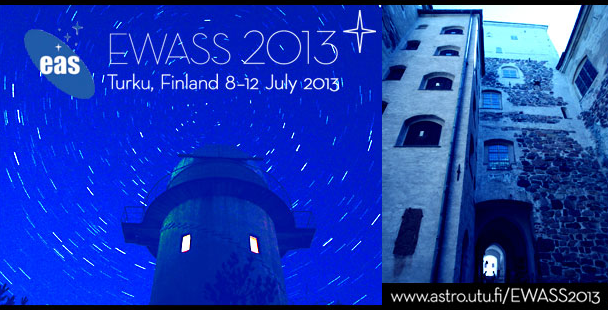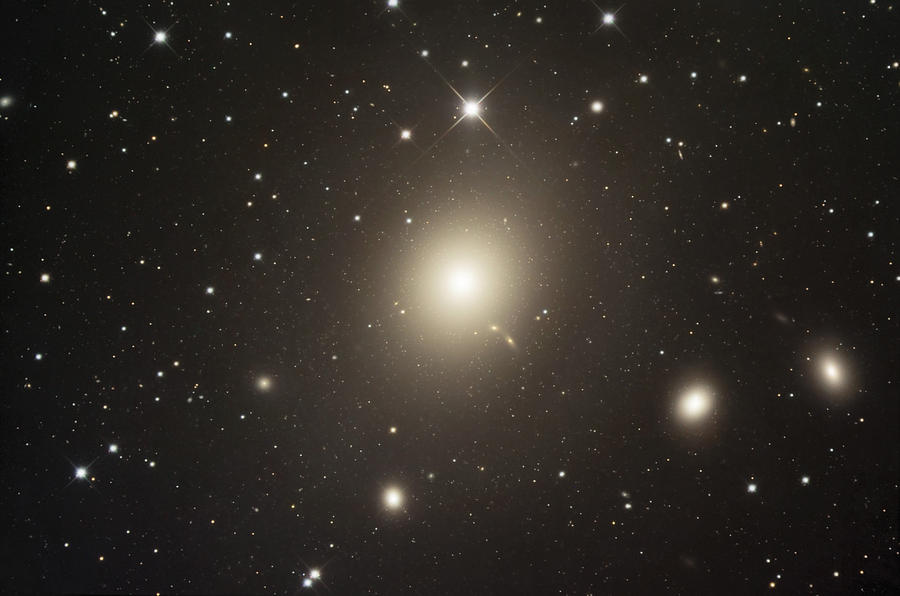The mystery of ellipticals
The mystery of ellipticals - Symposium 4 at EWASS 2013 (Monday-Tuesday, July 8-9th, 2013)
Aim of the Symposium:
Numerous detailed observations over the last decade have confirmed the existence of a spectacular population of
massive and extremely compact quiescent galaxies at redshifts of z~2, which has no present day counterpart.
Their descendants underwent significant structural evolution (size growth by a factor of 3-5, decrease of the effective
stellar densities by several orders of magnitude, changes in the mass distribution) and are now, most likely, part of the
local early-type galaxy (ETG) population. At this Symposium we intend to bring together world leading experts to report
and discuss the most recent observational and theoretical aspects of the structural evolution of early-type galaxies
focusing on the following two topics:
- Properties of compact early-type galaxies at z~2 and their evolution with redshift
What are the best current observational constraints on the typical sizes, shapes, masses and velocity dispersions of these
galaxies? How common are they compared to the general z~2 galaxy population? What is known about their evolution towards
the present day? What are the observational constraints on merger rates? What are their progenitors at higher redshift? What
type of galaxies are the local descendants of the compact massive early-type galaxies? Is there a population present day counterparts
and what are their properties?
- Theoretical implications for theories on ETG formation
How did the compact massive galaxies form? What physical mechanisms can explain the observed size growth? Are there alternatives
to minor merging? What are the observable consequences for the different formation scenarios and what are the best observational tests?
What remains of the traditional models for ETG formation (spiral mergers, monolithic collapse)?
Important dates:
Late February: registration is open. For more information see the bottom of this page.
May 31st, 2013: deadline for early registration
May: programme released
July 8-9, 2013: Symposium
Program:
6 invited review talks, 25 mins each (IR)
7 invited highlight talks, 20 mins each (IH)
17 contributed talks, 15 mins each
8 posters
Monday, 8th of July 2013
1. Observations and stellar populations of early-type galaxies at low redshift
Session Chair: Peter Johansson
- 11.45-11.50 Welcome
- 11.50-12.10 Claudia Maraston (IH): "The mysteriously simple stellar populations of elliptical galaxies"
- 12.10-12.35 Daniel Thomas (IR): "The stellar populations of elliptical galaxies"
- 12.35-12.50 Francesco La Barbera:
- 12.50-13.05 Esther Marmol-Queralto:
- 13.05-13.20 Denija Crnojevic:
13.15-14.30 Lunch:
- 14.30-14.45 Anna Ferre-Mateu: "The mysterious properties of local compact massive galaxies: not what we expected"
2. Observations and stellar populations of early-type galaxies at high redshift
Session Chair: Pablo Perez-Gonzalez
- 14.45-15.10 Ignacio Trujillo (IR):
- 15.10-15.30 Jesse van de Sande (IH):
- 15.30-15.45 Mattia Fumagalli: "How dead are dead galaxies?"
- 15.45-16.00 Ignacio Ferreras:
16.00-16.30 Coffee break & Poster Session I:
- 16.30-16.45 Carlos Lopez-Sanjuan:
- 16.45-17.00 Vivienne Wild:
- 17.00-17.15 Elizabeth McGrath: "Quiescent Disks in the Early Universe"
- 17.15-17.30 Caroline Straatman: "The evolution and formation of star forming and quiescent galaxies to z=4 from Z-FOURGE"
- 17.30-17.45 Fernando Buitrago:
- 17.45-18.00 Veronica Strazzullo:
Tuesday, 9th of July 2013
3. Observations and modelling of early-type galaxy dynamics
Session Chair: Francesco Shankar
- 11.45-12.10 Michele Cappellari (IR):
- 12.10-12.30 Chiara Spiniello (IH):
- 12.30-12.45 Adriana Gargiulo:
- 12.45-13.00 Sperello di Serego Alighieri: "Do compact ellipticals at z~1-2 also have larger velocity dispersion?"
4. Early-type galaxies in semi-analytic models
Session Chair: Ignacio Trujillo
- 13.00-13.20 Rob Yates (IH):
13.15-14.30 Lunch:
- 14.30-14.55 Francesco Shankar (IR):
- 14.55-15.10 Martin Stringer:
5. Early-type galaxies in numerical simulations
Session Chair: Daniel Thomas
- 15.10-15.35 Peter Johansson (IR):
- 15.35-15.50 Elena Ricciardelli:
- 15.50-16.05 Rhea-Silvia Remus:
16.00-16.30 Coffee break & Poster Session II:
- 16.30-16.50 Ewald Puchwein (IH):
- 16.50-17.10 Chervin Laporte (IH): "The Growth in Size and Mass of Cluster Galaxies since z= 2"
6. New/future observing facilities
Session Chair: Michele Cappellari
- 17.10-17.35 Pablo Perez-Gonzalez (IR):
- 17.35-17.55 Javier Cenarro (IH): "The Javalambre-PAU Astrophysical Survey: A Low Resolution IFU of the Northern Sky"
Posters:
- Hugo Ledo:
- Ilaria Lonoce: "Star Formation History of z~1 Early-type galaxies"
- Martín López-Corredoira:
- Ronald Läsker:
- Antonina Marino:
- Russell Smith: "ESO325-G004: A massive elliptical galaxy with a lightweight IMF", see http://arxiv.org/abs/1306.4983
- Sonia Tamburri:
- Heidi Yli-Kankahila: "Numerical studies of the chemical enrichment in disk galaxy merger remnants"
The Scientific Organizing Committee:
- Peter Johansson (Helsinki, co-chair)
- Thorsten Naab (MPA, co-chair)
- Jeremiah Ostriker (Columbia, Princeton)
- Daniel Thomas (Portsmouth)
- Ignacio Trujillo (IAC, Tenerife)
Registration and Abstract submission:
Participants to this Symposium need to register for the EWASS week via the Registration and Accommodation page.
All participants who wish to present a contribution at this Symposium should submit their abstract via the central
Abstracts page of EWASS 2013. Oral contributions that are not selected due to insufficient time slots, can be presented in poster format.

